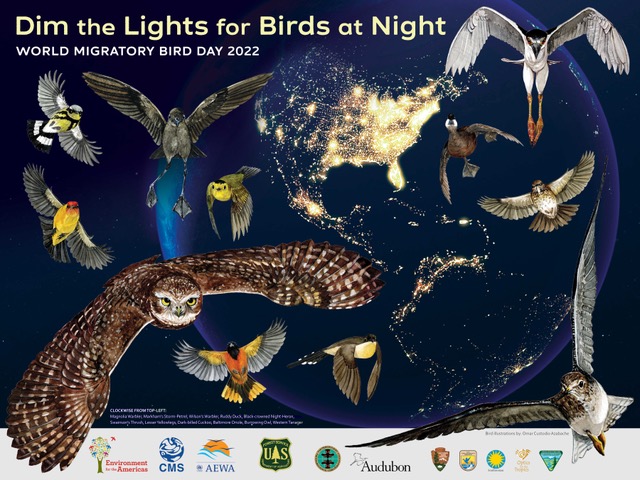
May 14 is World Migratory Bird Day (WMBD). The overall mission of this globally recognized event is to raise awareness of migratory birds and protect them by recognizing issues related to their conservation. Over the years, WMBD has focused on issues such as climate change, plastic pollution, the illegal killing of birds, and barriers to migration. The theme for 2022 is focused on light pollution.

Since the beginning of time, all life on Earth has relied on the natural, predictable rhythm of day and night. However, over time, humans have disrupted this cycle by lighting up the night sky. Much like our necessary desire for clean water, air, and soil, natural darkness has great conservation value and needs to be protected.
The rhythm that was once encoded in the DNA of all plants and animals on Earth has now been altered by light pollution. Light pollution refers to artificial illumination that alters the natural patterns of light and dark in an ecosystem—and it’s increasing all over the world. Artificial lighting is commonly used to illuminate the night sky for streets, bridges, monuments, security, landmarks, and much more. According to a light pollution study from Science Advances, “Today, more than 80% of the world’s population lives under a ‘lit sky’, a figure closer to 99% in Europe and North America.”
How Light Pollution Impacts Migratory Birds
So, what does light pollution have to do with birds? For many species, light pollution can drastically alter behaviors such as foraging, activity levels, energy expenditures, and vocal communication. Birds that migrate at night such as ducks, geese, sandpipers, songbirds, and plovers, are particularly exposed and impacted by light pollution. Nocturnally migrating birds are attracted to and disoriented by artificial light. This can lead species to circle illuminated areas, causing depleted energy, risking exhaustion, and increasing the possibility of predation and fatal collision with buildings and infrastructure. The connection between light pollution and these collisions contributes to millions of bird fatalities each year.
Addressing Light Pollution
Encouraging decision-makers who play a key role in addressing light pollution to extend conservation measures for migratory birds is key to generating influential change. The Convention on Migratory Species (CMS) has already established internationally agreed guidelines to reduce light pollution for migratory shorebirds, seabirds, and marine turtles. New guidelines are currently under development to include migratory land birds and bats which will be presented for adoption at the 2023 CMC Conference of the Parties.
Our Promega Fitchburg campus, along with all other businesses in the city, is required to meet Dark Sky regulations, city ordinances, and governmental guidelines. This includes dark sky-certified outdoor lighting to minimize glare while reducing light trespass and skyglow. Outdoor lighting has benefits such as safety and security but should not be used in excess. Using outdoor lighting more sparingly helps avoid glare and unnecessary waste of energy and financial resources. According to the International Dark Sky Association, about 30% of all outdoor lighting in the United States is wasted. Here are a few of the many ways you can reduce the effects of light pollution:
- Have a clear purpose for your outdoor lighting and only use it as needed.
- Update your outdoor lights to ensure they are fully shielded: fixtures must shield the bulb, lamp, or glowing lens and light should be completely downward-directed.
- Switch to LED lights to reduce illuminance without compromising visibility (color temperature should be around 3000 Kelvins).
- Invest in lights that are on a timer or motion detector to reduce overuse and set them on the shortest time setting.
- Minimize your blue light emissions by switching to warm-colored light bulbs (red, yellow, and orange colors).
- Use window treatments like blinds and curtains in your home to shield interior lights from glowing outdoors.
Addressing light pollution for migratory birds means addressing light pollution for all life on Earth. Each and every species in our ecosystem is connected in one way or another. Small changes create a large impact. When each individual contributes in their own way, we all contribute to a more sustainable future.
To explore the extent of light pollution in your region, use this interactive map for a bird’s eye view of the lights in your town.
Learn more about how you can get involved and take action on the World Migratory Bird Day website.
Read more about our global commitment to preserving and improving the natural environment at our Corporate Responsibility Website.
Related Posts
Riley Bell
Latest posts by Riley Bell (see all)
- Bringing Science to Life: How Art and Sustainability Shape Our New Trade Show Booth Design - March 31, 2025
- Genetic Symphonies: Building Hox of Life - December 17, 2024
- Exploring the World Through the Promega and Eppendorf Family Exchange Program - November 19, 2024
